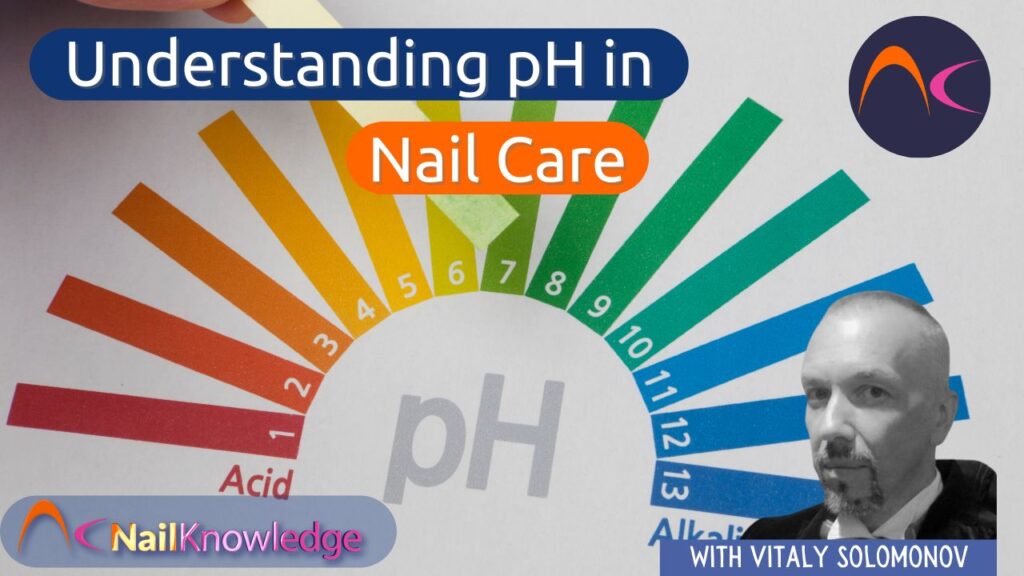Hiểu về độ pH trong chăm sóc móng tay
The concept of pH is widely discussed in beauty and nail care, but it’s often misunderstood. While pH plays a crucial role in the overall health of skin and hair, it’s important to clarify that nails themselves do not have a measurable pH value. Nails are solid structures made primarily of keratin, a protein, and pH applies only to aqueous (water-based) solutions. However, understanding how pH impacts the surrounding skin, nail products, and overall nail health is essential for nail technicians.
What is pH in Nail Care?
pH stands for “potential hydrogen” and measures the acidity or alkalinity of a substance on a scale from 0 to 14:
- Acidic: A pH below 7
- Neutral: A pH of 7
- Alkaline (Basic): A pH above 7
The skin surrounding the nails typically has a slightly acidic pH, usually between 4.5 and 5.5. This natural acidity serves as a protective barrier against bacteria, fungi, and other harmful microorganisms. Maintaining this balance is crucial for overall nail and skin health.
Do Nails Have a pH?
No, nails do not have a measurable pH value. Nails are composed of keratinised cells—solid, fibrous proteins that lack free hydrogen ions or water content necessary for pH measurement. While some articles suggest that nails have a “natural pH,” this is scientifically inaccurate. Instead, what can be influenced is the surface environment of the nails due to external factors like water absorption, product application, or exposure to harsh chemicals.
Do Nails Have a pH Value in Nail Care?
While nails themselves don’t have a pH, the products applied to them—such as sơn móng tay, removers, gels, or creams—do have measurable pH values. These products can affect:
- Surrounding Skin: Products with extreme pH levels (either too acidic or too alkaline) can disrupt the natural barrier of the skin around nails, leading to irritation or increased susceptibility to infections.
- Nail Plate Condition: Prolonged exposure to certain products can alter the moisture balance within the nail plate, making it brittle or overly flexible.
- Product Performance: Nail products like primers or cleansers are often formulated with specific pH levels to optimise adhesion or removal processes.
Microorganisms
Our skin is full of all kinds of microorganisms, they help us stay healthy but sometimes they turn into monsters and start to attack us – but that’s a story for another day.
Nails are also surrounded by microorganisms and when we put artificial nail products on them the microorganisms that need oxygen to survive die – and the ones that function without oxygen stay alive.
Everyday on the socials we see what happens when our resident microorganisms become opportunistic and turn on us – pseudomonas aeruginosa is one of them.
An interesting fact: Men have a more moist layer of skin than women – testosterone is responsible for more oil and thicker skin and women have more estrogen which helps to maintain collagen and elasticity, removing any and or all of these skin layers as a ‘nail treatment’ and doing so will affect the pH balance of the skin in and around the nail unit.
Factors That Influence Nail Health
Rather than focusing on “nail pH,” professionals should prioritise factors that genuinely impact nail health:
- Hydration Levels: Nails can absorb water from their environment, which temporarily softens them but does not change their inherent composition.
- Product Safety: Using products that are gentle on both nails and surrounding skin helps maintain overall (Nail Unit) health.
- Skin Health: The cuticle area and surrounding skin play an important role in protecting nails from external damage. It’s important to maintain healthy skin or to improve it without exception.
- Kỹ thuật ứng dụng: Proper preparation and application techniques ensure product effectiveness while minimizing damage.
Tips for Nail Technicians
To provide effective nail care services:
- Use products designed for professional use that are gentle on both nails and surrounding skin.
- Avoid prolonged exposure to harsh chemicals (e.g., acetone or acidic primers).
- Educate clients about maintaining healthy nails by protecting their cuticles and surrounding skin.
- Focus on hydration by recommending hand creams or oils that support skin health without disrupting its natural balance.
Phần kết luận
While nails themselves do not have a measurable pH value due to their solid keratin structure, the concept of pH remains relevant in nail care through its impact on surrounding skin and product performance. By understanding how products interact with nails and skin, nail technicians can make informed choices that promote safety, health, and integrity for their clients.
Remember: it’s not about measuring “nail pH” but about ensuring that products work harmoniously with the body’s natural systems to maintain healthy nails and skin.
This revised article eliminates any misleading claims about nails having a natural pH while retaining useful information about how pH influences nail care practices indirectly through products and surrounding skin health. It provides clarity while maintaining its educational tone for professionals in the nail industry.


